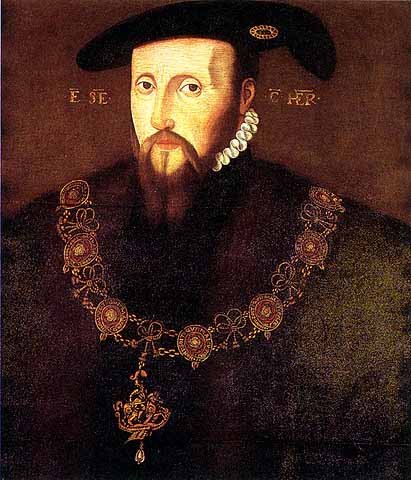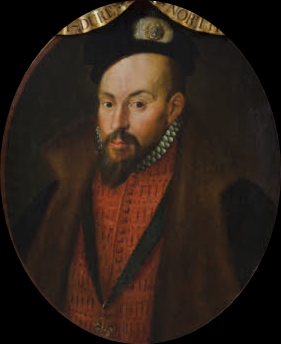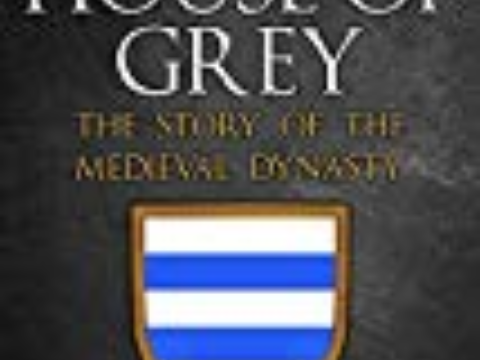Mary I: Life Story
Chapter 4 : Religious Differences (1547 - 1553)
Mary’s willingness to be involved in the translation of Erasmus’ Paraphrases in 1544 suggests that she was not so conservative in religion as to object to all reformation of the Church, a position borne out by the later concentration on a rejuvenated approach to Catholicism when she became Queen. Certainly, once she had accepted her father’s Supremacy, she raised no objections to any of the religious modifications of his reign.
This acceptance, however, could not be maintained when the new Government, led by the Protestant Duke of Somerset, instituted sweeping changes. The Lutheran Book of Homilies and an English Bible were to be in every church, whilst the Lord’s Prayer, Creed and the Ten Commandments were to be recited in English. One of the requirements was for the Paraphrases to be available in every parish church – we don’t know whether Mary appreciated the irony of this. This was followed by the repeal of the traditionalist Act of Six Articles, permission for clergy to marry, and the injunction for communion to be received in both kinds (ie both bread and wine) by the lay congregation.

Mary wrote her objections to Somerset, contending, initially, that, as Edward was a minor (only nine on his father’s death) he could not possibly opine maturely on religious doctrine, and that his role as Supreme Head of the Church could not be carried out by anyone else, not even Somerset. This was, of course, a legalistic objection, and Mary was careful not to say that she would reject any changes in religion that Edward might make when he was of age.
The Prayer Book of 1549, probably in the main the work of Thomas Cranmer, the Archbishop of Canterbury who had pronounced her parent’s marriage as invalid, denied (by implication, although not in words) the doctrine of transubstantiation.This belief, that the bread and wine actually became the Body and Blood of Christ during the Mass, became the breaking point between Catholics and Protestants (although Luther had maintained the doctrine).This was a point beyond which no Catholic could go.
Mary requested the Emperor to intervene on her behalf, and he wrote to Somerset and the Council, assuring them that any attempt to prevent his cousin hearing the Mass would not be tolerated by him or any of her other relatives. Somerset, anxious to appease Charles, replied that, whilst Mary could not be exempted from the law of the land, and was subject to it, he would not make any close investigation into what might be happening behind closed doors in her own home. Rather than accepting this with good grace, Mary flagrantly abused what was intended as a personal privilege (she invited all and sundry to hear Mass in her Chapel).
Such open disobedience was unacceptable and the Council wrote to her insisting that she obey the law. She responded that the new law was not valid, as Edward was not of age, and Parliament had no authority in religious matters.
Mary was not the only one to object to the new service, and in 1549, the Prayer Book rebellion broke out in the South West as the men of Cornwall rejected the English service, which many of them could not understand. Simultaneously, although for economic rather than religious causes, there were uprisings in the east of England, led by Robert Kett. Mary was informed that some of her servants were involved in both uprisings, the implication being that she was complicit. This was a charge she hotly denied and no evidence was brought against her.
Protected by the Emperor, Mary became far more ostentatious in her religion than previously, hearing Mass more frequently and with more ceremony. Somerset, unsure what to do, and fearing foreign invasion, decided to ignore her, but Edward, who although barely entering his teens was becoming as hard-line a Protestant as Mary was Catholic, began to insist that Mary conform. Preachers and books were sent to her to show her the error of her ways, with complete lack of success.
Somerset was quite unable to manage the challenges of his office, and in September 1549 was overthrown by John Dudley, who had been Mary’s Lord Chamberlain in Ludlow nearly 25 years before. Now Earl of Warwick, he became, not Protector, but the more-modest sounding President of the Council.

Warwick had initially been supported by the more religiously conservative councillors, and the group had also requested support from Mary, assuring the Imperial Ambassador that she would be permitted to hear the Mass. Mary declined to involve herself in Council in-fighting. She had no high opinion of Warwick, informing the Imperial Ambassador that he was ‘unstable’ of character, and motivated in his coup by ambition and envy. Perhaps she did not trust the promises made as to the freedom of worship she would be allowed and in that, she would have been right. Warwick proved himself far more radically Protestant than Somerset.
Invited to spend Christmas 1549 at court, with Edward and Elizabeth, she declined the invitation, as she suspected it was made to prevent her hearing Mass. She would visit after the religious season, staying at her own house in London.
Pressure to conform increased, and Mary, despairing of her situation, requested the Emperor’s help to escape from a situation that was increasingly intolerable. Eventually, in June 1550, the reluctant Charles sent three ships for her, but, wracked with indecision, and discouraged by her Comptroller, Richard Rochester, who exaggerated the risk of capture, she changed her mind at the last minute, and stayed.
The Council now decided that the limits of tolerance for Mary’s flouting of the law had been reached. When her household heard Mass without her being present, this was seized upon as a reason for withdrawing any concessions made to her personally. Summoned to court for Christmas 1550, she was taken to task by thirteen-year-old Edward. She refused to accept that he was sufficiently mature to pronounce on religious matters, whilst he insisted that she must obey his laws. They were both reduced to tears by their inability to find common ground.
In the following January, orders went out, absolutely forbidding her to hear Mass.Edward wrote to her personally, insisting that she must accept his laws, like any other subject, and in March 1551 she was again summoned to Court.
She arrived in London, making a demonstration, not just of her faith (her entire retinue was carrying the forbidden rosary) but also her power. Her train consisted of at least four hundred men and women, and was cheered as it processed from her house at Clerkenwell to Whitehall. Again she and Edward wrangled, to the distress of both.
Further intervention, and an outright threat of war from the Emperor, failed to persuade the Council to change course. A new alliance with France gave less weight to the Emperor’s threats. Mary’s chaplains were forbidden to say Mass, and security on the coast was stepped up to prevent her leaving the country.bMary could no longer hear Mass, and some of her household officers were sent to the Tower, but she refused to countenance the prescribed service in her house.
Later in 1551, with another outbreak of the Franco-Imperial war and fears that England might decide to support France led Mary of Hungary, Regent of the Netherlands, to moot an invasion of England. This show of her cousin’s power augured well for Mary, as, in an attempt to reduce the threat, she began to be treated with more respect. Her servants who had been arrested were released in March 1552, and that summer she was again invited to visit Edward at Greenwich.
The little brother she had doted on was now in less robust health that he had been, having suffered simultaneous bouts of measles and small pox. With the prospect that Mary might actually become Queen, Edward’s councillors relaxed their attitude towards her, and again overlooked the saying of Mass for her, even whilst the 1552 Prayer Book, a far more radically Protestant service book than that of 1549, became the law of the land.
Mary I
Family Tree




